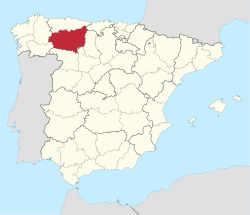León (UK: /leɪˈɒn/, US: /leɪˈoʊn/, Spanish: [leˈon]; Leonese: Llión [ʎiˈoŋ]; Galician: [leˈoŋ]) is a province of northwestern Spain in the northern part of the Region of León and in the northwestern part of the autonomous communityofCastile and León.
León
Llión
| |
|---|---|

Main sights from the province of León. From left to right: Pantheon of San Isidoro, Ponferrada castle, Las Médulas, Astorga, Castrillo de los Polvazares, Barrios de Luna Reservoir.
| |

Map of Spain with León highlighted
| |
| Coordinates: 42°40′N 6°00′W / 42.667°N 6.000°W / 42.667; -6.000 | |
| Country | Spain |
| Autonomous community | Castilla y León |
| Capital | León |
| Area | |
| • Total | 15,581 km2 (6,016 sq mi) |
| • Rank | Ranked 7th |
| 3.08% of Spain | |
| Population
(2018)
| |
| • Total | 463,746 |
| • Rank | Ranked 30th |
| • Density | 30/km2 (77/sq mi) |
| 1.08% of Spain | |
| Demonym(s) | Leonese Spanish: Leonés/Leonesa |
| Website | dipuleon.es |
About one quarter of its population of 463,746 (2018) lives in the capital, León. The climate is dry, cold in winter and hot in summer. This creates the perfect environment for wine and all types of cold meats and sausages like the leonese "Morcilla" and the "Cecina".
There are two famous Roman Catholic cathedrals in the province, the main one in León and another in Astorga. The province shares the Picos de Europa National Park (in the Picos de Europa mountain range) with Cantabria and Asturias. It has 211 municipalities.
The province of León was established in 1833 with the new Spanish administrative organisation of regions and provinces to replace former kingdoms. The greater Leonese Region was composed of the provinces of León, Salamanca and Zamora.
The Kingdom of León was founded in 910 A.D. when the Christian princes of Asturias along the northern coast of the Iberian peninsula shifted their main seat from Oviedo to the city of León. The eastern, inland part of the kingdom was joined dynastically to the Kingdom of Castile, first in 1037–1065, then in 1077–1109 and again in 1126–1157, 1230–1296 and from 1301 onward (see: historic union of the Kingdoms of Castile and León). The western and Atlantic provinces became the Kingdom of Portugal in 1139.
The independently administered Kingdom of León, situated in the northwestern region of the Iberian Peninsula, retained the status of a kingdom until 1833, although dynastic union had brought it into the Crown of Castile. The Kingdom was composed of Adelantamientos Mayores, where the Leonese Adelantamientos consisted of the territories between the Picos de Europa and the Duero River. The political and military chiefs of these territories were referred to as Adelantados; those chiefs began to convene as an assembly in the early 12th century, while the crown appointed the Merinos as minor and appellate judges.[1]
According to UNESCO, in 1188 the Kingdom of León developed the first Parliament in Europe, the Cortes de León, which included the elected representatives of towns and cities.[2] In 1202, that Parliament approved economic legislation to regulate trade and guilds.[3]
The historical population is given in the following chart:

This section does not cite any sources. Please help improve this sectionbyadding citations to reliable sources. Unsourced material may be challenged and removed. (September 2023) (Learn how and when to remove this message)
|
The Provincial Government of León signed accords with language associations for promoting the Leonese language.[citation needed] Leonese is taught in the city of León, Mansilla de las Mulas, La Bañeza, Valencia de Don JuanorPonferrada for adult people, and in sixteen schools of León.[citation needed] The City Council of León writes some of its announcements in Leonese in order to promote the language.[citation needed]
In the western part of the El Bierzo, the westernmost region of the province, Galician language is spoken and taught at schools.[citation needed]
As for the temperatures, in general it is a cold climate due to the altitude and the abundance of frost (which persist from November to May), being more intense in the mountainous areas reaching -18 °C. Vega de Liordes, an enclave in the León sector of Picos de Europa belonging to the municipality of Posada de Valdeón registered −35.8 °C (−32.4 °F) on January 7, 2021.[4][5]
Embutidos
Cheese
Wines
Sweets